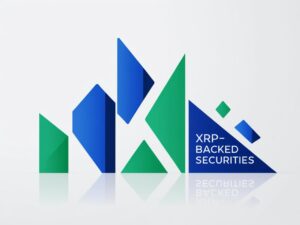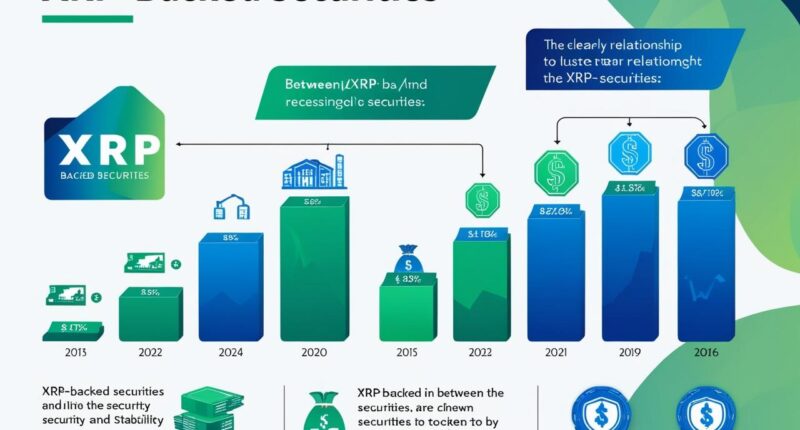XRP-backed securities are financial instruments linked to the value of XRP, allowing investors to gain exposure to its price movements in a regulated manner. These securities, which include futures contracts, options, exchange-traded funds (ETFs), and depository receipts, provide a structured way for traditional investors to participate in the cryptocurrency market. By ensuring regulatory compliance and enabling fast transactions, they attract interest from various investors. Further insights about their advantages and risks are available for exploration.

As the cryptocurrency market continues to evolve, XRP-backed securities have emerged as a significant financial instrument, offering investors a way to engage with the value of XRP without directly owning the cryptocurrency. These financial instruments derive their value from the price movements of XRP, providing indirect exposure to the cryptocurrency’s fluctuations. This approach serves as a bridge between traditional finance and the crypto markets, creating a regulated pathway for institutional investors to participate. Additionally, these securities appeal to institutions seeking cross-border payments due to Ripple’s technology, which enables fast, low-cost transactions. Furthermore, XRP transactions are processed in a few seconds, offering a significant advantage over traditional banking methods. Ripple’s focus on bank partnerships has further solidified its position in enhancing cross-border payment solutions.
There are several types of XRP-backed securities available in the market. Investors may choose from XRP futures contracts, which allow them to speculate on future prices, or XRP options contracts, which provide the right, but not the obligation, to buy or sell XRP at a set price. Additionally, XRP-backed exchange-traded funds (ETFs) and XRP depository receipts offer ways to invest in XRP without the challenges of custody. Furthermore, XRP-backed bonds and notes provide another avenue for generating returns linked to XRP’s performance.
The advantages of these securities include a lower entry barrier for traditional investors who may be hesitant to invest directly in cryptocurrencies. They also contribute to increased liquidity in XRP markets, while ensuring regulatory compliance and investor protections.
Diversification of investment portfolios becomes easier, as these instruments allow exposure to XRP without the complexities of managing digital assets directly. Market participants include institutional investors seeking crypto exposure, banks, asset managers, and even retail investors through ETFs.
However, the regulatory landscape for XRP-backed securities varies by country and jurisdiction, with ongoing discussions and developments affecting their approval and market entry.
Pricing and valuation of XRP-backed securities closely track the spot price of XRP and are influenced by supply and demand dynamics, market sentiment, and news regarding regulations. Despite the benefits, investors should remain aware of risks, such as the high volatility of XRP, regulatory uncertainties, counterparty risks, and potential liquidity issues. Understanding these elements is critical for informed investment decisions in this evolving market.
Frequently Asked Questions
Are Xrp-Backed Securities Regulated by Any Government Authority?
XRP-backed securities are indeed regulated by various government authorities. The SEC oversees these securities in the United States, requiring registration and adherence to anti-fraud laws.
The CFTC regulates XRP futures and derivatives, ensuring market integrity. Additionally, state regulators enforce local laws and investigate potential fraud.
Internationally, regulations differ, with upcoming frameworks like the EU’s MiCA and oversight from countries such as Japan and Singapore, each imposing specific requirements for XRP-related activities.
How Do Xrp-Backed Securities Differ From Traditional Securities?
XRP-backed securities differ from traditional securities primarily in their ownership structure and regulatory status. They represent direct ownership of XRP tokens, without underlying company shares.
Unlike traditional securities, which are often traded on stock exchanges and regulated by authorities, XRP-backed securities trade on crypto exchanges, offering 24/7 access.
They also exhibit higher volatility and lack dividends, with returns reliant solely on XRP’s price movements, presenting distinct risks and opportunities for investors.
Can Individuals Invest in Xrp-Backed Securities?
Individuals generally face challenges when trying to invest in XRP-backed securities. These investments are mostly available to institutional investors who must meet high minimum investment thresholds.
Retail investors often cannot participate due to regulatory restrictions. However, emerging options, such as XRP ETFs and fractional ownership models, may provide alternative pathways.
Additionally, individuals can explore indirect investment methods like purchasing shares of companies with XRP exposure or investing in crypto-focused funds.
What Risks Are Associated With Xrp-Backed Securities?
XRP-backed securities carry several risks that investors should consider.
Market volatility can lead to price fluctuations, causing potential losses during sudden downturns.
Regulatory uncertainty, particularly from ongoing legal actions, may affect trading and adoption.
Additionally, liquidity risks arise from a limited secondary market, making it difficult for investors to sell their holdings.
Operational risks, such as cybersecurity threats and smart contract vulnerabilities, further complicate the safety of these financial products.
How Are Xrp-Backed Securities Taxed in Different Jurisdictions?
XRP-backed securities are taxed differently across various jurisdictions.
In the United States, they are considered property, subject to capital gains tax upon sale.
The European Union lacks a unified tax policy, with some countries offering exemptions after a year.
Singapore imposes income tax on trading profits but has no capital gains tax.
In Japan, gains are taxed as miscellaneous income, with rates from 5% to 45%, and losses can offset gains.
References
- https://trustwallet.com/blog/guides/beginners-guide-to-xrp-backed-securities
- https://walloftraders.com/blog/en/xrp-cryptocurrency-advantages-controversies/
- https://cointelegraph.com/learn/articles/what-are-xrp-backed-securities
- https://www.investopedia.com/what-is-xrp-6362550
- https://www.satoshitango.com/global/currencies/ripple
- https://blog.tothemoon.com/articles/what-is-ripple-and-what-is-xrp-backed-by
- https://calebandbrown.com/blog/what-is-xrp/
- https://primexbt.com/for-traders/is-ripple-a-good-investment/
- https://osl.com/academy/article/a-beginners-guide-what-is-xrp-all-about
- https://xrpl.org/docs/introduction/what-is-xrp









